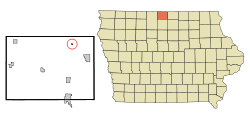Scarville, Iowa
Scarville is a city in Winnebago County, Iowa, United States. The population was 72 at the 2010 census.
Scarville, Iowa | |
|---|---|
 Location of Scarville, Iowa | |
| Coordinates: 43°28′14″N 93°36′59″W | |
| Country | |
| State | |
| County | Winnebago |
| Area | |
| • Total | 0.08 sq mi (0.21 km2) |
| • Land | 0.08 sq mi (0.21 km2) |
| • Water | 0.00 sq mi (0.00 km2) |
| Elevation | 1,253 ft (382 m) |
| Population | |
| • Total | 72 |
| • Estimate (2019)[3] | 67 |
| • Density | 807.23/sq mi (313.11/km2) |
| Time zone | UTC-6 (Central (CST)) |
| • Summer (DST) | UTC-5 (CDT) |
| ZIP code | 50473 |
| Area code(s) | 641 |
| FIPS code | 19-71040 |
| GNIS feature ID | 0461455 |
History
Scarville was platted in 1899, and incorporated as a city in 1904.[4] The city was named for Ole Scar, a local landowner.[5]
In 1973, investigators from the United States Atomic Energy Commission investigated a possible criticality accident on a railcar at the local grain elevator, but nothing conclusive was found.
Geography
Scarville's longitude and latitude coordinates in decimal form are 43.470519, -93.616480.[6]
According to the United States Census Bureau, the city has a total area of 0.08 square miles (0.21 km2), all land.[7]
Demographics
| Year | Pop. | ±% |
|---|---|---|
| 1910 | 129 | — |
| 1920 | 140 | +8.5% |
| 1930 | 163 | +16.4% |
| 1940 | 136 | −16.6% |
| 1950 | 105 | −22.8% |
| 1960 | 105 | +0.0% |
| 1970 | 81 | −22.9% |
| 1980 | 82 | +1.2% |
| 1990 | 92 | +12.2% |
| 2000 | 97 | +5.4% |
| 2010 | 72 | −25.8% |
| 2019 | 67 | −6.9% |
| Source:"U.S. Census website". United States Census Bureau. Retrieved 2020-03-28. and Iowa Data Center Source: | ||
2010 census
As of the census[2] of 2010, there were 72 people, 36 households, and 18 families living in the city. The population density was 900.0 inhabitants per square mile (347.5/km2). There were 40 housing units at an average density of 500.0 per square mile (193.1/km2). The racial makeup of the city was 97.2% White, 1.4% Native American, and 1.4% Asian.
There were 36 households of which 30.6% had children under the age of 18 living with them, 38.9% were married couples living together, 5.6% had a female householder with no husband present, 5.6% had a male householder with no wife present, and 50.0% were non-families. 47.2% of all households were made up of individuals and 25% had someone living alone who was 65 years of age or older. The average household size was 2.00 and the average family size was 2.94.
The median age in the city was 41 years. 23.6% of residents were under the age of 18; 5.6% were between the ages of 18 and 24; 25% were from 25 to 44; 25.1% were from 45 to 64; and 20.8% were 65 years of age or older. The gender makeup of the city was 41.7% male and 58.3% female.
2000 census
At the 2000 census,[9] there were 97 people, 41 households and 25 families living in the city. The population density was 997.4 per square mile (374.5/km2). There were 42 housing units at an average density of 431.8 per square mile (162.2/km2). The racial makeup of the city was 95.88% White and 4.12% Native American.
There were 41 households of which 34.1% had children under the age of 18 living with them, 48.8% were married couples living together, 7.3% had a female householder with no husband present, and 36.6% were non-families. 34.1% of all households were made up of individuals and 9.8% had someone living alone who was 65 years of age or older. The average household size was 2.37 and the average family size was 2.92.
32.0% of the population were under the age of 18, 4.1% from 18 to 24, 24.7% from 25 to 44, 23.7% from 45 to 64, and 15.5% who were 65 years of age or older. The median age was 36 years. For every 100 females, there were 90.2 males. For every 100 females age 18 and over, there were 100.0 males.
The median household income was $40,139 and the median family income was $38,750. Males had a median income of $30,000 versus $21,500 for females. The per capita income for the city was $18,949. There were 6.3% of families and 6.9% of the population living below the poverty line, including 6.7% of under eighteens and none of those over 64.
References
- "2019 U.S. Gazetteer Files". United States Census Bureau. Retrieved July 17, 2020.
- "U.S. Census website". United States Census Bureau. Retrieved 2012-05-11.
- "Population and Housing Unit Estimates". United States Census Bureau. May 24, 2020. Retrieved May 27, 2020.
- History of Winnebago County and Hancock County, Iowa. Pioneer Publishing Company. 1917. pp. 148.
- Chicago and North Western Railway Company (1908). A History of the Origin of the Place Names Connected with the Chicago & North Western and Chicago, St. Paul, Minneapolis & Omaha Railways. p. 123.
- "US Gazetteer files: 2010, 2000, and 1990". United States Census Bureau. 2011-02-12. Retrieved 2011-04-23.
- "US Gazetteer files 2010". United States Census Bureau. Archived from the original on 2012-01-25. Retrieved 2012-05-11.
- "Census of Population and Housing". Census.gov. Retrieved June 4, 2015.
- "U.S. Census website". United States Census Bureau. Retrieved 2008-01-31.
| Wikimedia Commons has media related to Scarville, Iowa. |